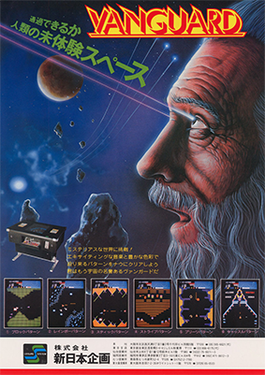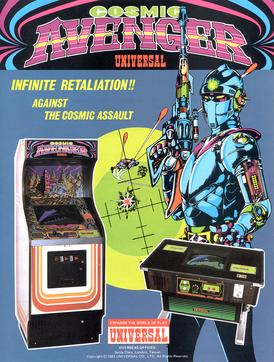
The Atari 2600 is a home video game console developed and produced by Atari, Inc. Released in September 1977, it popularized microprocessor-based hardware and games stored on swappable ROM cartridges, a format first used with the Fairchild Channel F in 1976. Branded as the Atari Video Computer System from its release until November 1982, the VCS was bundled with two joystick controllers, a conjoined pair of paddle controllers, and a game cartridge—initially Combat and later Pac-Man.

ColecoVision is a second-generation home video-game console developed by Coleco and launched in North America in August 1982. It was released a year later in Europe by CBS Electronics as the CBS ColecoVision.

Millipede is a fixed shooter video game released in arcades by Atari, Inc. in 1982. The sequel to 1981's Centipede, it has more gameplay variety and a wider array of insects than the original. The objective is to score as many points as possible by destroying all segments of the millipede as it moves toward the bottom of the screen, as well as eliminating or avoiding other enemies. The game is played with a trackball and a single fire button which can be held down for rapid-fire.
GameLine was a dialup game distribution service for the Atari 2600, developed and operated by Control Video Corporation (CVC). Subscribers could install the proprietary modem and storage cartridge in their home game console, accessing the GameLine service to download games over a telephone line. GameLine had an exclusive selection of games, and its pioneering business model eventually gave rise to America Online. Despite being ahead of its time, it wasn't very popular, possibly due to its price of $60 for the hardware, $15 for the membership fee, and $1 per game, which you could only keep for a week.

Congo Bongo, also known as Tip Top, is an platform game released as an arcade video game by Sega in 1983. A message in the ROM indicates it was coded at least in part by the company Ikegami Tsushinki. The game is viewed in an isometric perspective, like Sega's earlier Zaxxon (1981), but does not scroll. Numerous home ports followed.
1982 was the peak year for the golden age of arcade video games as well as the second generation of video game consoles. Many games were released that would spawn franchises, or at least sequels, including Dig Dug, Pole Position, Mr. Do!, Zaxxon, Q*bert, Time Pilot and Pitfall! The year's highest-grossing video game was Namco's arcade game Pac-Man, for the third year in a row, while the year's best-selling home system was the Atari 2600. Additional game consoles added to a crowded market, notably the ColecoVision and Atari 5200. Troubles at Atari late in the year triggered the video game crash of 1983.

Venture is a fantasy-themed action game released in arcades in 1981 by Exidy. Each level consists of a playable, overhead map view. Upon entering one of the rooms shown on the map, the game zooms in until the room fills the screen. As a round smiley-face named Winky, the goal is to collect the treasure in each of the rooms. Winky can shoot arrows at enemies which turn into slowly disintegrating corpses when hit. Corpses are still deadly to the touch.

Atlantis is a fixed shooter video game released by Imagic in July 1982 for the Atari 2600. It was written by Dennis Koble who also wrote Trick Shot, Solar Storm, and Shootin' Gallery for Imagic. Atlantis was ported to the Atari 8-bit family, VIC-20, Intellivision, and the Magnavox Odyssey 2. The game was inspired by Taito's 1981 Colony 7 arcade game.

Super Cobra is a horizontally scrolling shooter developed by Konami, originally released as an arcade video game in 1981. It was published by Konami in Japan in March 1981 and manufactured and distributed by Stern in North America on June 22. It is the spiritual sequel to the Scramble arcade game released earlier in 1981. Super Cobra contains eleven distinct sections, versus six in Scramble, and is significantly more difficult, requiring maneuvering through tight spaces early in the game.

Vanguard is a scrolling shooter arcade video game developed by TOSE. It was released by SNK in Japan and Europe in 1981, and licensed to Centuri for manufacture in North America in October and to Zaccaria in Italy the same year. Cinematronics converted the game to cocktail arcade cabinets in North America. The player flies a ship through forced-scrolling tunnels with sections that move horizontally, vertically, or diagonally, to reach a boss at the end. The ship is controlled with an 8-way joystick, and it can fire in four directions via four buttons in a diamond arrangement.
In the history of video games, the second generation era refers to computer and video games, video game consoles, and handheld video game consoles available from 1976 to 1992. Notable platforms of the second generation include the Fairchild Channel F, Atari 2600, Intellivision, Odyssey 2, and ColecoVision. The generation began in November 1976 with the release of the Fairchild Channel F. This was followed by the Atari 2600 in 1977, Magnavox Odyssey² in 1978, Intellivision in 1980 and then the Emerson Arcadia 2001, ColecoVision, Atari 5200, and Vectrex, all in 1982. By the end of the era, there were over 15 different consoles. It coincided with, and was partly fuelled by, the golden age of arcade video games. This peak era of popularity and innovation for the medium resulted in many games for second generation home consoles being ports of arcade games. Space Invaders, the first "killer app" arcade game to be ported, was released in 1980 for the Atari 2600, though earlier Atari-published arcade games were ported to the 2600 previously. Coleco packaged Nintendo's Donkey Kong with the ColecoVision when it was released in August 1982.

Pac-Man is a 1982 maze video game developed and published by Atari, Inc. under official license by Namco, and an adaptation of the 1980 hit arcade game of the same name. The player controls the title character, who attempts to consume all of the wafers while avoiding four ghosts that pursue him. Eating flashing wafers at the corners of the screen will cause the ghosts to turn temporarily blue and flee, allowing Pac-Man to eat them for bonus points.

Cosmic Ark is an Atari 2600 game designed by Rob Fulop and published by Imagic in 1982. The objective is to gather specimens from different planets in a spaceship which contains the survivors from the city of Atlantis. There are two versions of the cartridge. One allows the player to toggle the starfield display with the Black & White / Color TV switch. In the other the starfield cannot be disabled.

Tutankham is a 1982 arcade video game developed and released by Konami and released by Stern in North America. Named after the Egyptian pharaoh Tutankhamun, the game combines a maze shoot 'em up with light puzzle-solving elements. It debuted at the European ATE and IMA amusement shows in January 1982, before releasing worldwide in Summer 1982. The game was a critical and commercial success and was ported to home systems by Parker Brothers.

Cosmic Avenger is a horizontally scrolling shooter developed by Universal Entertainment Corporation and released in arcades by Universal in July 1981. It is one of the first shooters with forced horizontal scrolling along with Konami's Scramble released earlier in the year. The final installment in Universal's Cosmic series, players take control of the Avenger space fighter and use bullets and bombs against enemy forces.

The Atari 2600 hardware was based on the MOS Technology 6507 chip, offering a maximum resolution of 160 x 192 pixels (NTSC), 128 colors, 128 bytes of RAM with 4 KB on cartridges. The design experienced many makeovers and revisions during its 14-year production history, from the original "heavy sixer" to the Atari 2600 Jr. at the end. The system also has many controllers and third-party peripherals.

M Network was a video game division of Mattel that, in the 1980s, produced games in cartridge format for the Atari 2600 video game system.
Zimag was the name used by Magnetic Tape International to market consumer products, including video games and blank audio cassettes, VHS tapes, and floppy disks. Magnetic Tape International was a wholly owned subsidiary of Intermagnetic Corporation. The company released games for the Atari 2600 and Atari 8-bit family of home computers in 1982 and 1983. The 2600 titles are games from Bit Corporation ported from PAL to NTSC and with different names. The Atari 8-bit computer titles were developed by Syncro, Inc.

Mines of Minos is an Atari 2600 maze video game developed and published by CommaVid in 1982. The player controls a mining robot in a maze, fighting off alien attackers. A two-player mode, in which the second player can control an alien, is also available.















